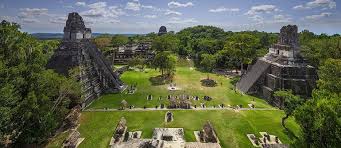Book of Mormon Geography - Mesoamerica Theory
Readers and scholars of the Book of Mormon are frequently curious about the exact location of the Book of Mormon peoples. Although the location has not been revealed by prophets to members of The Church of Jesus Christ of Latter-day Saints, theories regarding the geography of the Book of Mormon have been present since its publication.
Since the beginning of the discovery of ruins in the Yucatan Peninsula and Guatemalan jungle, members of the Church have discerned their connection to Book of Mormon ancient civilization. As more archaeological findings, such as the ruins of the Maya, Inca, and Olmec civilizations, are excavated and studied, believers of the historicity of the Book of Mormon continue to see connections.
For instance, in 2018, a laser aerial survey in northern Guatemala revealed long-hidden complex ruins.[1] Although Book of Mormon Central takes a “geography neutral” stance on the subject, the team also “follows the evidence wherever it might lead.” Following the news of these discoveries, it published an article entitled “4 Ways the New Maya Discoveries May Relate to the Book of Mormon.” Read the article here.
Support for a Mesoamerica Theory
One could argue that the leaders of the Church have defined the Book of Mormon lands as placed in North America, which could mean only the United States or it could mean the continent encompassing the United States and Central American countries.
FairMormon published an article by Tyler Livingston listing the number of Book of Mormon geography expressions during Joseph Smith’s time. Although his summary is not exhaustive, he writes that “there is enough information to answer the question of what the early beliefs and teachings of the saints in Joseph Smith’s time were.”[2] Livingston argues that no theory was consistently taught and that speculation was allowed.
One of the proponents for a limited Mesoamerica setting is John L. Sorenson, an emeritus professor of anthropology at Brigham Young University and author of An Ancient American Setting for the Book of Mormon, Mormon’s Map, Mormon’s Codex, and other books and articles on the Book of Mormon and archaeology.
The Living Heritage Tours website includes a partial list from Sorenson’s Mormon’s Codex of culture references to the Mayan society and a corresponding reference from the Book of Mormon.[3]
For decades, members of the Church yearning to explore the possible Book of Mormon lands have traveled with companies that offer Book of Mormon land tours and cruises featuring Mayan ruins. The popularity of these tours suggests that members of the Church are willing to accept the possibility that Mesoamerica was the home of at least some of the peoples of the Book of Mormon.
Statement from The Church of Jesus Christ of Latter-day Saints
In an article entitled "Book of Mormon Geography" under "Gospel Topics" on the Church's official website—released on January 29, 2019—the position of The Church of Jesus Christ of Latter-day Saints is declared:
- Since the publication of the Book of Mormon in 1830, members and leaders of The Church of Jesus Christ of Latter-day Saints have expressed numerous opinions about the specific locations of the events discussed in the book. Some believe that the history depicted in the Book of Mormon—with the exception of the events in the Near East—occurred in North America, while others believe that it occurred in Central America or South America. Although Church members continue to discuss such theories today, the Church’s only position is that the events the Book of Mormon describes took place in the ancient Americas. . . .
- The Church does not take a position on the specific geographic locations of Book of Mormon events in the ancient Americas. President M. Russell Ballard, Acting President of the Quorum of the Twelve Apostles, reminded members that “the Book of Mormon is not a textbook on topography. Speculation on the geography of the Book of Mormon may mislead instead of enlighten; such a study can be a distraction from its divine purpose.”
- Individuals may have their own opinions regarding Book of Mormon geography and other such matters about which the Lord has not spoken. However, the First Presidency and Quorum of the Twelve Apostles urge leaders and members not to advocate those personal theories in any setting or manner that would imply either prophetic or Church support for those theories. All parties should strive to avoid contention on these matters.
- Speaking of the book’s history and geography, President Russell M. Nelson taught: “Interesting as these matters may be, study of the Book of Mormon is most rewarding when one focuses on its primary purpose—to testify of Jesus Christ. By comparison, all other issues are incidental.”[4]
